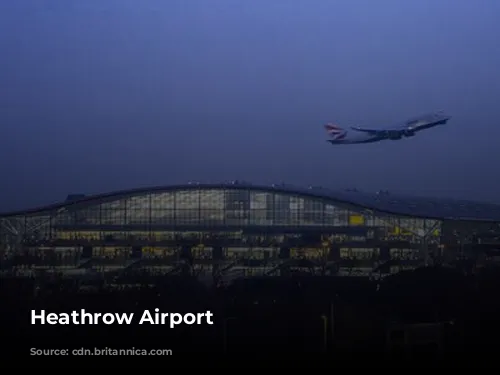Heathrow Airport, the largest and busiest airport in the United Kingdom and a major international hub, is a testament to the power of air travel. Opened in 1946, this global gateway connects over 200 destinations in more than 80 countries, making it one of the world’s busiest airports. British Airways, the airport’s dominant airline, operates half of its flights, with Dubai, New York City, and Madrid being the most popular destinations.
This opening paragraph introduces the topic of Heathrow Airport, highlighting its significance as a major international hub and emphasizing its global reach.

From Humble Beginnings to a Global Powerhouse
Heathrow’s story began in 1930 when Richard Fairey, a British engineer and aircraft builder, purchased a 150-acre plot of land in the village of Harmondsworth. He built a private airport, the Great West Aerodrome, with a single grass runway and a few small buildings. During World War II, the British government took over Fairey’s airstrip, renaming it RAF Heston, and using it as a base for long-range flights.
This paragraph details the early history of Heathrow, focusing on its humble beginnings as a private airfield and its transformation into a strategic military base during World War II.
A New Dawn: From Military Base to International Airport
After the war, the Royal Air Force transferred the airfield to the Air Ministry for civilian use. On January 1, 1946, it officially became London Airport, launching its first passenger flight to Buenos Aires. The initial airport had no permanent buildings, but with the rapid growth of commercial air travel in the 1950s, the need for permanent structures became evident. British architect Frederick Gibberd was tasked with designing the airport’s new facilities, culminating in the construction of two modern terminals in 1961. In 1966, London Airport was officially renamed Heathrow Airport.
This paragraph discusses the transformation of Heathrow from a military airfield to a civil airport, highlighting the rapid growth of air travel and the subsequent development of permanent structures. It concludes with the official renaming of the airport in 1966.

Expansion and Growth: Meeting the Demands of a Growing World
As air travel continued to grow, Heathrow expanded to accommodate the increasing number of passengers. Terminal 4 opened in 1986, followed by the airport’s largest terminal, Terminal 5, in 2008. Designed by Richard Rogers, Terminal 5 serves as the departure point for most British Airways flights. The airport also boasts its own private railway, the Heathrow Express, which provides a direct link to London Paddington station, offering a convenient and fast journey. Heathrow is easily accessible by car, the Elizabeth Line, and the London Underground’s Piccadilly Line.
This paragraph focuses on the expansion of Heathrow Airport to meet the growing demands of air travel, highlighting the addition of new terminals, a dedicated railway link, and various transportation options.

The Future of Heathrow: A Vision for Continued Growth
Heathrow Airport is a major employer, providing jobs for approximately 75,000 people, making it one of the UK’s largest single-site employers. With the number of passengers consistently growing, plans for expansion, including a third runway, have been discussed for years. Although the plan was approved in 2019, construction has yet to begin. The future of Heathrow, with its planned expansion and continued focus on providing efficient and convenient travel, remains to be seen.
This paragraph discusses the future of Heathrow Airport, focusing on its role as a major employer and the ongoing debate surrounding its expansion. It concludes with an open-ended statement about the future of the airport.
Heathrow Airport, a testament to the evolution of air travel, has grown from humble beginnings to a global gateway connecting people and cultures worldwide. From its initial use as a private airfield to its transformation into a major international hub, Heathrow has consistently adapted to meet the demands of a changing world. While the future of the airport remains uncertain, its commitment to providing efficient and convenient travel for millions of passengers worldwide is undeniable.








